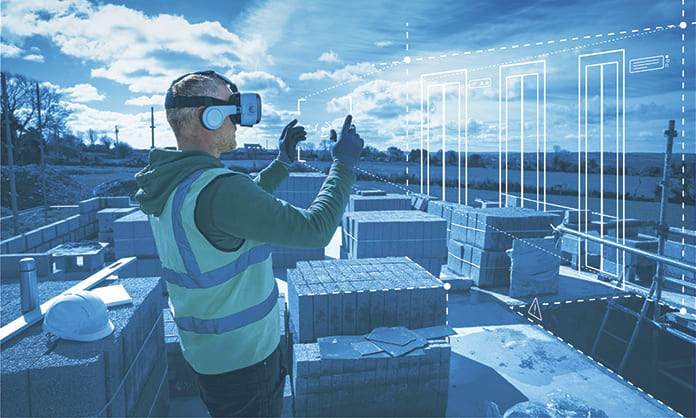What digital technologies will transform the construction industry over the coming decade? And how might they be adopted so that companies come out on the right side of this transformation? BIM+ investigates.
Construction is one of the least digitised sectors, but in a world where there’s a smartphone in almost every pocket, this can’t continue. Other industries are benefiting from technology and change is coming to construction too.
By 2030, population growth, urbanisation and economic expansion are predicted to increase global demand for construction output by 85%. This growth is set against a backdrop of low productivity, rising project complexity, the low margins and constrained finances of the traditional business model, the skills gap, the high amount of waste generated, and more.
Construction must go digital and embrace new ways of delivering buildings and infrastructure. From strategy to business development, innovation, operations, projects, functions – digital technology will touch all of them.
When sensors drive work pipelines, algorithms design estimates and big data powers scheduling, the result will be a more profitable, resilient and agile industry, and a better built environment. As technology use matures in the industry, business models will also evolve, and new ones will emerge. Traditional barriers to entry – capital, knowledge, efficiencies – will be broken down by digital technologies.
This article will examine a digital vision for construction and a roadmap for how to get there.
Where will the industry gain most from digital technologies over the coming decade? What are the specific technologies that can bring about these improvements? And how might they be adopted so that companies come out on the right side of this transformation?
Where: The urgency of digitising construction
The industry faces some pressing challenges that threaten the long-term future of many companies. But it also faces opportunities to reinvent and improve itself. In both cases digital technology holds the key:
1. Improved productivity and profitability. Digital technology is already making a difference for early adopters and technology has the potential to offer a fast track to transforming the selection, funding and delivery of projects – making processes more efficient, faster and cheaper. In turn, this will improve profitability across the supply chain. In non-residential construction, 10 years of full-scale digitalisation could save up to $1.2trn in the design, engineering and construction phases, and $0.5 trn in the operations phase.
2. Faster, more efficient construction. It’s been reported that just a quarter of construction projects come within 10% of their original deadlines. The industry’s highly fragmented supply chains are a main contributor, but technology is poised to offer a key solution to the challenge. Digital technologies will make the construction process more efficient by bringing these key parties together.
3. Greater predictability. Better supply chain integration will result in better quality buildings and infrastructure. Digital technologies improve collaboration, allowing everyone to access the same data in real time, to test approaches and catch errors earlier.
4. Safer projects. Assuring onsite safety has always been important. As projects increase in size and complexity, technology will enable managers to do even more to protect their people. Drones, for example, allow contractors to carry out surveys, inspect eaves or look at chimneys without their feet leaving the ground.
5. Attracting the talent of tomorrow. Firms that implement a digital strategy to include people along with processes and technology are more successful in attracting and retaining talent. For example, 80% of employees prefer to work for digital leaders. Employers who don’t offer opportunities for employees to develop their digital skills are five times more likely to see people leave the company within a year.
6. Better outcomes for clients and end users. Digital technologies can help the industry to make better decisions about what assets to build, as well as the mix and nature of those assets to ensure projects meet expectations. For example, smart sensors collecting data on occupancy, usage patterns and energy consumption might allow owners and constructors to lower costs, increase capacity, improve end-user experience, or even maximise value by identifying new usage capabilities.
7. New business models. Digital technologies are disruptive. They have the power to break and remake business models, reshape definitions of value in markets, and create not only new competitors, but help companies compete differently too.
Asset data combined with large external datasets such as population demographics and wealth levels could help contractors invest in projects with a greater degree of confidence. A contractor that understands how assets perform across their lifecycle could unlock other service models.

Digital technology will allow faster and more efficient construction
What: 10 transformational technologies
The interaction between technologies is fundamentally transforming the very way in which we design, build and operate buildings and infrastructure. And those changes are about to transform the industry by radically improving collaboration, productivity, quality and safety, reducing environmental impact, changing business models, and even creating or replacing job roles.
The following 10 key technologies offer considerable potential to help drive transformation of the construction industry over the next 10 years. Most of them are available now.
1. Infinite computing in the cloud. Cloud computing will give even the smallest contractors access to “infinite”, on-demand processing power. The cloud’s unlimited computing power can solve complex design problems, simulating thousands of different designs to find the ones offering the best solution that meets the required design criteria.
2. Big Data. Data and its effective collection, analysis, communication and management are central to digital transformation. Patterns in the data generated by building information modelling (BIM) for example, can identify possible problems in the project or across the supply chain.
Want to learn more?
Get hold of the full discussion paper, Reimagining construction: The Vision for Digital Transformation, written by Autodesk in collaboration with the Chartered Institute of Building, here:
www.autodesk.co.uk/campaigns/ciob-reimagining-future-of-construction/paper
3. Symmetrical collaboration in the cloud. Connecting people and their workflows regardless of where they are within the supply chain or their physical location will defeat inefficient flows of information to increase productivity and deliver more predictable projects.
4. Collision of the digital and physical worlds. Augmented reality (AR) and virtual reality (VR) will allow mistakes to be spotted in the virtual world before they make it to the real world.
5. Site automation. Site-surveying drones provide an easier, more comprehensive and safer way to perform surveys, scans and inspections, and harness real-world data to improve speed and quality.
6. Machine learning and artificial intelligence (AI). With data about past behaviours or current workloads, machine learning – a type of AI – could play a significant role in mitigating risk in project management at the construction site. For example, it could automatically assign priority to issues, or “risk scores” to subcontractors.
7. Prefabrication and digital fabrication. Pre- and digital fabrication could allow the industry to unlock manufacturing-style standardisation and productivity levels, and accelerate end-to-end project delivery by minimising the number of on-site physical “touches” and waste.
8. Internet of Things. Buildings and infrastructure sensors and systems linked by the IoT will allow better use of information to make the asset more responsive to the needs of its owners and occupants, inform future work pipelines, and improve the built environment.
9. The Blockchain. This technology could add transparency to every type of agreement and transaction. For example, contractors could automatically be paid following successful inspections, wherever they are in the supply chain.
10. Social and mobile computing. Consider the benefits of digital marketplaces where contractors can “crowdsource” problem-solving or access, on demand, the best skills at the right time, in the right place.
How: Steps to digital transformation
Digital transformation can be daunting for those just starting out. Breaking the journey down into key steps helps to make the whole process more manageable. Drawing on the insight of experts and those working in the industry, this roadmap highlights the steps construction firms need to take to realise a new and more successful future.
1. Manage technology strategically. For “at scale” digitalisation, leadership needs to fully understand the potential of digital technology and how to make it flourish through changes to organisational structure, skills investment and culture.
2. Adopt a “just do it” mindset. Seek opportunities for involvement in your organisation’s digital transformation and think creatively about the challenges and their solution.
3. Educate and skill the workforce. At the heart of digitalisation is a need for a digitally skilled workforce. There needs to be a push to change qualifications, courses and apprenticeship programmes to include digital skills and introduce more digital training programmes on site.

Using AR and VR will allow any mistakes to be spotted first in the digital world
4. Learn from other industries. The sector can be made more attractive to new talent through technology. For example, what can the construction industry learn from manufacturing, with its high productivity and its lean, systematic method for waste minimisation?
5. Professional development. Include the skills and knowledge needed for a flexible mindset towards digital technology, workflows and data management.
6. Digitise processes, optimise data use and collaborate. Today, BIM workflows are being adopted across the supply chain, evolving from a tool that has historically been used to drive efficiency within design, into one that connects design to the build process, and from there to facilities management.
7. Data is central to digital transformation. Use digital tools to solve problems, streamline workflows, optimise data management, promote collaboration and share information across the supply chain.
Plotting the roadmap
It’s an exciting time to be in construction, as digital technologies promise to bring about unprecedented change. But there’s no point waiting for the competition to get ahead. Now is the time to embark on your digital transformation journey.
Successful organisations will be those whose business leaders integrate digital technologies into their corporate strategy and put in place initiatives to break down barriers to adoption. And successful individuals will be those who proactively drive their own professional development to build the vision, plot the roadmap and “just do it”.
This article has been produced in association with Autodesk

Case study: Mace’s data centre
The contractor used cloud-based construction management and boosted employee productivity 21%
Mace used cloud-based construction management tools for the construction of the new Clonee Data Centre, resulting in employees being 21% more productive and managers being 35% more productive overall.
Supported by 100% wind energy, the Clonee Data Centre in Ireland is a complex that includes a pair of 25,000 sq m (approximately 269,000 sq ft) data halls. As many as 1,500 people per day contributed to the construction of these centres.
To keep the project on track, general contractor Mace Technology relied on Autodesk’s BIM 360 cloud-based platform for construction management and the integrated BIM tools in the Autodesk Architecture, Engineering & Construction Collection.
“We orchestrated the whole project in BIM 360 with schedules linked to models,” says Paddy Ryan, program BIM lead for Mace. “During construction, we validated activities as they happened. It’s important to not just have a solid plan, but also to validate progress against it. Delays, defects, and surprises are less likely when you align what’s happening in the field – as it happens – to what’s in the plan.”
After completing phases one and two of the project using BIM 360 during construction, Mace decided to use BIM 360 to spearhead preconstruction coordination for phase three. This allowed for cloud-based clash detection using design models, which let the entire project team review and address issues and adopt lessons learned from previous phases.
Mace automated the process of aggregating the design team’s Revit BIM models, reducing the time spent each week on model management from 440 minutes to just 10. Because Navisworks project-review software integrates simply with BIM 360 in the cloud, design, construction, and client-side teams could collaborate in real time on up-to-date, automatically federated models and automated clash reports.
This tight connection across teams and locations helped Mace manage supply-chain performance and track progress in real time. The result was reduced RFIs, rework and time spent in meetings.
Using cloud-based construction management on the project, Mace reports that managers saved more than 13 hours each week – helping them be 35% more productive overall. Typical site users saved 12 hours each week on document control. Organisations that participated in the quality assurance and controls processes saved more than 14 hours each week.
Mace determined that employees on the construction site that were actively contributing information to BIM 360 were 21% more productive overall.
















